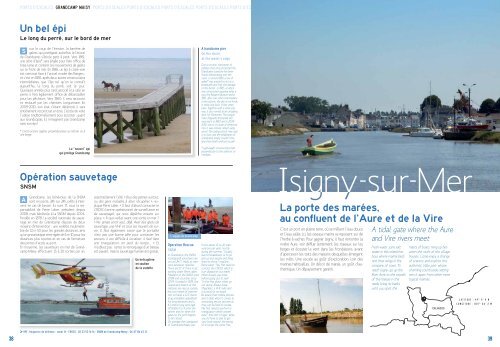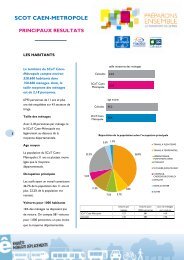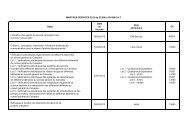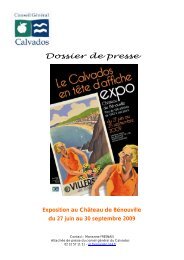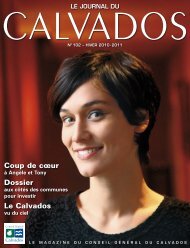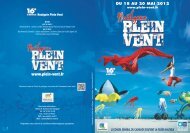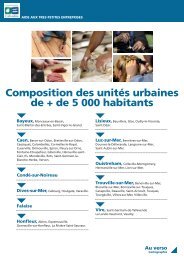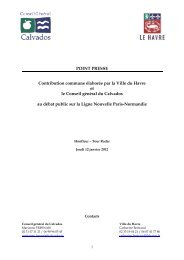PORTS D’ESCALES GRANDCAMP MAISY PORTS D’ESCALES PORTS D’ESCALES PORTS D’ESCALES PORTS D’ESCALES PORTS D’ESUn bel épiLe long <strong>du</strong> perré, sur le bord de merous le coup de l’érosion, la barrière deS galets qui protégeait autrefois le littoralde Grandcamp s’étiole petit à petit. Vers 1861,une série d’épis* sera érigée pour faire office debrise-lame et contenir les mouvements de galetssur le front de mer. En 1865, un épi à claire-voieest construit face à l’actuel musée des Rangers ;et c’est en 1881, après deux autres constructionsintermédiaires, que l’épi tel qu’on le connaîtaujourd’hui, le long <strong>du</strong> perré, voit le jour.Quelques années plus tard, associé à la cale enpierre, il fera également office de débarcadèrepour les pêcheurs. Vers 1960, il sera raccourciet restauré par les chantiers Longuemare. En2009-2010, son état s’étant détérioré, il seraentièrement reconstruit en bois. L’école de voilel’utilise traditionnellement pour accoster ; quantaux Grandcopais, ils n’imaginent pas Grandcampsans son épi !* Constructions légères perpendiculaires au littoral ou àune berge.Le “nouvel” épiqui protège GrandcampA handsome pierOn the shore,at the water’s edgeDue to erosion, the barrier ofpebbles that once protected theGrandcamp coastline has beenslowly deteriorating over theyears. In around 1861 a row ofspikes* was erected to act as abreakwater and limit the damageto the barrier. In 1865, a latticewas constructed opposite what isnow the Rangers Museum and in1881, after two other intermediaryconstructions, the pier as we knowit today was built. A few yearslater, together with a stone slipway,it also served as an unloadingdock for fishermen. The Longuemareshipyards shortened andrestored it in 1960 and in 2009-2010, <strong>du</strong>e to its state of deterioration,it was entirely rebuilt usingwood. The sailing school now usesit to dock and the inhabitants ofGrandcamp simply couldn’t imaginetheir beach without its pier!* Lightweight constructions builtperpendicular to the seafront orriverbankOpération sauvetageSNSMGrandcamp, les bénévoles de la SNSMÀ sont en poste, 24h sur 24h, prêts à interveniren cas de besoin. Ils sont 17, sous la responsabilitéde Pierre Laber, président depuis2008, mais bénévole à la SNSM depuis 2004.Fondée en 1878, la société nationale de sauvetageen mer de Grandcamp dispose de deuxmoyens d’intervention : une vedette insubmersiblede 12 m 50 pour les grandes distances, ainsiqu’un pneumatique semi-rigide de 6 m 10 pour lesdistances plus courtes et en cas de fermeturedes portes d’accès au port.En moyenne, les sauveteurs en mer de Grandcamp-Maisyeffectuent 15 à 20 sorties par an,essentiellement l’été. « Pour des pannes surtout,ou des gens malades à aller récupérer », expliquePierre Laber. « Il faut d’abord contacter leCROSS (centre opérationnel de surveillance etde sauvetage), qui nous dépêche ensuite surplace. » À quoi veiller avant une sortie en mer ?« Ne jamais sortir seul, déjà. Avoir des gilets desauvetage, une VHF et tous les moyens de survie.Il faut également savoir que le portablen’est pas une bonne idée pour contacter lessecours, il est difficile à localiser, il faut faireune triangulation, on perd <strong>du</strong> temps... » Etn’oubliez pas : certes le remorquage d’un bateauest payant, mais le sauvetage humain est gratuit.Un hélicoptèreen soutiende la vedetteL’équipe de GrandcampOperation RescueSNSMIn Grandcamp, the SNSM(coastguard) volunteers areon call 24/7, ready to intervenewhenever need be.There are 17 of them in all,working under Pierre Laber,President of the SNSM since2008 and volunteer since2004. Founded in 1878, theGrandcamp branch of thenational sea rescue societyhas two means of interventionon hand: a 12.5-metrelong unsinkable speedboatfor long distances and a6.1-metre long semi-rigidinflatable for shorter distancesand for when thegates to the port happento be closed.On average the coastguardof Grandcamp-Maisy performsabout 15 to 20 interventionsper year, mostly<strong>du</strong>ring the summer. “Usually<strong>du</strong>e to breakdowns or to gopick up sick people and bringthem to shore,” explainsPierre Laber. “You first need tocontact the CROSS which inturn dispatches our teams.”What should you knowbefore going out to sea?“In the first place, never goout alone. Always havelifejackets, a VHF radio anda survival kit on board.Be aware that mobile phonesaren’t ideal when it comes tocontacting rescue services asthey can be hard to locate.We first need to perform atriangulation which wastestime.” And don’t forget, whileyou do have to pay to getyour boat towed, the savingof a human life come free.La porte des marées,au confluent de l’Aure et de la VireC’est un port en pleine terre, où se mêlent l’eau douceet l’eau salée. Ici, les oiseaux marins se reposent sur del’herbe à vaches. Pour gagner Isigny, il faut remonter larivière Aure, voir défiler lentement les roseaux sur lesberges et écouter le vent dans les frondaisons, avantd’apercevoir les toits des maisons desquelles émergentles mâts. Une escale au goût d’exploration, loin desmarinas habituelles. Un décor de marais, un goût d’authentique.Un dépaysement garanti.A tidal gate where the Aureand Vire rivers meetFresh water joins saltwater in this inland harbourwhere marine birdsrest their wings in thecompany of cows. Toreach Isigny, go up theRiver Aure to the soundsof the breeze in thereeds lining its banksuntil you spot themasts of boats rising up betweenthe roofs of the villagehouses. Come enjoy a changeof scenery and explore thisauthentic little port whosecharming countryside settingsets it apart from other moretypical marinas.CALVADOSLATITUDE : 49° 9’ 4 NLONGITUDE : 001° 06’ 2 W> VHF, fréquence de détresse : canal 16 - CROSS : 02 33 52 16 16 - SNSM de Grandcamp-Maisy : 06 47 86 63 13.38 39
ISIGNY SUR MER LATITUDE : 49° 9’ 4 N - LONGITUDE : 001° 06’ 2 W ISIGNY SUR MER ISIGNY SUR MER ISIGNY SUR MER ISIGNY SUR MER IPORTS D’ESCALES PORTS D’ESCALES PORTS D’ESCALES PORTS D’ESCALES PORTS D’ESCALES ISIGNY SUR MER PORTS D’ESCALELe port et ses servicesThe marina & its facilitiesEau à partir <strong>du</strong> pontonToilets: 1Water available Borne électriqueElectricity availableon pontoonà partir <strong>du</strong> pontonToilettes : 1Shower: 1CapacitéNombre de places :45 à flot dont 5 places visiteurs.Longueur : tout gabarit.Tirant d'eau : entre 0 et 6 m.Douche : 1Station servicePetrol station MécanicienEngineer Grue : 8 tonnesCrane: 8 tons Zone de carénageCareening zoneAu coeur des maraisPortes à flotsPortes, côté rivièrees portes à flots situées sur deux bras deD l’Aure, encadrent le port d’Isigny : lesportes <strong>du</strong> pont au Douet et <strong>du</strong> pont aux Vaches,aménagées en 1731 par Monseigneur de Nesmond,évêque de Bayeux. Actionnés par la forcede la marée motrice – fermeture des portes àmarée montante et ouverture à marée descendantesous la pression de l’eau des rivières –, cesponts éclusés empêchent l’eau de mer de pénétrerdans les marais avoisinant. Installées sur lesfleuves des marais <strong>du</strong> Cotentin, au début <strong>du</strong>XVIII ème , les portes à flots visaient à assainir lesterres, les rendre cultivables et contrôler la circulationde l’eau dans les prairies. Digues etpolders seront également érigés pour gagner desterres sur la mer et développer l’agriculture.Portes, côté merAt the heartof the marshlandsFlood gatesTwo flood gates situated onbranches of the Aure Riverflank the Isigny port: thegates of the Douet andVaches bridges, built in 1731by his eminence Monseigneurde Nesmond, the bishop ofBayeux. Activated by thestrength of the tide thatforces them open as it goesdown and closed as it rises,these lock bridges prevent thesea water from penetratingthe neighbouring marshes.The gates, built on the riversleading to the marshes ofCotentin in the beginning ofthe 18th century, were intendedto stabilise the earth makingit farmable and also tocontrol water circulation inthe meadows. Dykes andpolders were also built in aneffort to gain farmable groundand develop agriculture.Accès au bassinPar la Vire, 3 h avant et après lapleine mer. Zone marnante.AccueilServices Techniques – Mairie : ouvert<strong>du</strong> lundi au vendredi de 8h30 à 12 het de 13h30 à 17 h.CapacityNumber of berths:45 floating with 5 visitor spots.Length: all sizes.Draught: between 0 & 6m.Marina accessVia Vire, 3hrs before & after high tide.Intertidal zone.Opening hoursFacilities – Town hall: open Mondaythrough Friday from 8:30am to 12 noon& from 1:30pm to 5pm.BUREAU DU PORT Marina officeServices techniques (mairie) : Tél. 02 31 51 24 01 - Fax 02 31 51 32 70E-mail : mairie-isignysurmer-secretariat@wanadoo.fr - VHF Canal 9Autre OtherServices aux plaisanciers sur chantiers voisins :réparation et maintenance – bois.Facilities available on neighbouring sites:Repairwork & maintenance – wood.Information touristique Tourist informationOffice de tourisme intercommunal Isigny-Grandcamp - 16, rue Emile Demagny14230 ISIGNY-SUR-MERTél. 02 31 21 46 00 - isigny.tourisme@ccigi.fr - www.cc-isigny-grandcamp-intercom.frUn chantier au parfum d’autrefoisAtelier Archimèdeincent Gaignard entend bien faire ce qui luiV plait. En 2001, il s’associe à un autre charpentierde marine pour fonder l’Atelier Archimède :« Nous avons eu envie de reprendre l’ancienchantier Buisson, basé à Isigny-sur-Mer et quiconstruisait des doris et picoteux jusque dans lesannées ’90. Isigny nous plaisait pour l’ambiancede travail que nous en attendions. Aujourd’hui, jetravaille seul avec un salarié à mi-temps et deuxjeunes apprentis. L’atelier s’est spécialisé dansles bateaux anciens. » C’est l’amour <strong>du</strong> bois, desvieux gréements et des techniques de constructiontraditionnelles qui motive Vincent Gaignard.« Nous recherchons les techniques employées aumoment de sa construction pour rendre à unbateau sa forme originale, nous fouillons les archives.S’il le faut, j’utilise également des techniquesmodernes, je m’adapte aux besoins <strong>du</strong>bateau. » Une passion qui ne l’empêche pas deregarder vers l’avenir. « Je voulais essayer autrechose, donc, depuis quatre ans, nous construisonsdes roulottes* selon les techniques de constructionnavale. Je planche aussi sur un prototypede bateau plus modernepour faire de la randonnéenautique… » Quandtradition et modernitéfont bon ménage.* À Caen, vous avez peut-êtrecroisé la roulotte Hippo Facto, quivend des pro<strong>du</strong>its bio entre autres(mercredi et vendredi 11h30-14h, place de la République) et aété réalisée par l’atelier ?Vincent GaignardA shipyard that smellslike the oldendaysArchimedes' workshopVincent Gaignard has alwaysaimed to do as he pleases.In 2001, he collaborated withanother marine carpenter tofound the Archimedes Workshop."We felt like taking overthe old Buisson workshopbased in Isigny-sur-Mer which,up until the 90s, constructeddoris and little 'picoteux'boats (small fishing boatstypical of Lower Normandy).We chose Isigny for the workatmosphere we'd been lookingfor. Today, I work alonewith one salaried half-timeemployee and two young apprentices.The workshop specialisesin old boats." It is hislove for wood, old rigging andtraditional construction techniquesthat drives Vincent."We raid the archives tryingto preserve old techniquesused when the boats wereoriginally made in order toget a boat back into shape.When necessary I also usemodern techniques, I haveto adapt myself to the needsof the boat." Gaignard's passionfor all that is old doesnot prevent him from lookingto the future. "I wantedto try something else so,for three years now, we'vealso been making caravans*using naval constructiontechniques. I'm also workingAvec l’atelier Archimède,les bateaux retrouvent une jeunesseon a prototype for a moremodern boat designed forsea-hiking." When old andnew make one…* You may have come acrossthe Hippo Facto caravan<strong>du</strong>ring a trip to Caen whereyou can buy, among otherthings, organic pro<strong>du</strong>cts(Wednesdays and Fridaysfrom 11.30am to 2pm, placede la République). Thecaravan was made in theArchimedes Workshop.40> Atelier Archimède. Quai Surcouf - 14230 Isigny-sur-Mer - Tél. 02 31 22 20 12 - www.atelierarchimede.com - http://atelierdarchimed.canalblog.com41


